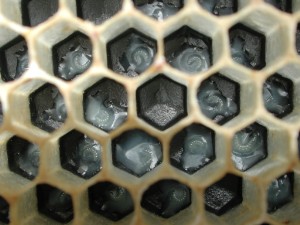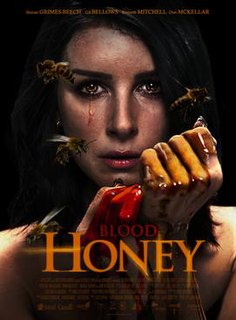Related Research Articles

A honey bee is a eusocial flying insect within the genus Apis of the bee clade, all native to Afro-Eurasia. After bees spread naturally throughout Africa and Eurasia, humans became responsible for the current cosmopolitan distribution of honey bees, introducing multiple subspecies into South America, North America, and Australia.

The Africanized bee, also known as the Africanized honey bee and known colloquially as the "killer bee", is a hybrid of the western honey bee, produced originally by crossbreeding of the East African lowland honey bee (A. m. scutellata) with various European honey bee subspecies such as the Italian honey bee (A. m. ligustica) and the Iberian honey bee (A. m. iberiensis).

A beehive is an enclosed structure in which some honey bee species of the subgenus Apis live and raise their young. Though the word beehive is commonly used to describe the nest of any bee colony, scientific and professional literature distinguishes nest from hive. Nest is used to discuss colonies that house themselves in natural or artificial cavities or are hanging and exposed. Hive is used to describe an artificial/man-made structure to house a honey bee nest. Several species of Apis live in colonies, but for honey production the western honey bee and the eastern honey bee are the main species kept in hives.

A beekeeper is a person who keeps honey bees.

Beekeeping is the maintenance of bee colonies, commonly in man-made hives, by humans. Most such bees are honey bees in the genus Apis, but other honey-producing bees such as Melipona stingless bees are also kept. A beekeeper keeps bees in order to collect their honey and other products that the hive produces, such as beeswax, propolis, flower pollen, bee pollen, and royal jelly, as well as to pollinate crops or to produce bees for sale to other beekeepers. A location where bees are kept is called an apiary or "bee yard".
An apiary is a location where beehives of honey bees are kept. Apiaries come in many sizes and can be rural or urban depending on the honey production operation. Furthermore, an apiary may refer to a hobbyist's hives or those used for commercial or educational usage. It can also be a wall-less, roofed structure, similar to a gazebo which houses hives, or an enclosed structure with an opening that directs the flight path of the bees.

In beekeeping, bee brood or brood refers to the eggs, larvae and pupae of honeybees. The brood of Western honey bees develops within a bee hive. In man-made, removable frame hives, such as Langstroth hives, each frame which is mainly occupied by brood is called a brood frame. Brood frames usually have some pollen and nectar or honey in the upper corners of the frame. The rest of the brood frame cells may be empty or occupied by brood in various developmental stages. During the brood raising season, the bees may reuse the cells from which brood has emerged for additional brood or convert it to honey or pollen storage. Bees show remarkable flexibility in adapting cells to a use best suited for the hive's survival.

A queen bee is typically an adult, mated female (gyne) that lives in a colony or hive of honey bees. With fully developed reproductive organs, the queen is usually the mother of most, if not all, of the bees in the beehive. Queens are developed from larvae selected by worker bees and specially fed in order to become sexually mature. There is normally only one adult, mated queen in a hive, in which case the bees will usually follow and fiercely protect her.

Stingless bees, sometimes called stingless honey bees or simply meliponines, are a large group of bees, comprising the tribe Meliponini. They belong in the family Apidae, and are closely related to common honey bees, carpenter bees, orchid bees, and bumblebees. Meliponines have stingers, but they are highly reduced and cannot be used for defense, though these bees exhibit other defensive behaviors and mechanisms. Meliponines are not the only type of bee incapable of stinging: all male bees and many female bees of several other families, such as Andrenidae, also cannot sting. Some stingless bees have powerful mandibles and can inflict painful bites.

Petro Prokopovych was a revolutionary Ukrainian beekeeper, the founder of commercial beekeeping and the inventor of the first movable frame hive. He introduced novelties in traditional beekeeping that allowed great progress in the practice. Among his most important inventions was a hive frame in a separate honey chamber of his beehive. He also invented a crude queen excluder between brood and honey chambers. Petro Prokopovych was also the first to ever model a 'bee beard' after delineating and calculating 'bee swarm behaviour", inspiring students for generations.
Ormond R. Aebi was an American beekeeper who was reported to have set the world's record for honey obtained from a single hive in one year, 1974, when 404 pounds of honey were harvested, breaking an unofficial 80-year-old record of 303 pounds held by A. I. Root. Together with his father Harry, the Aebi's wrote two books on beekeeping: The Art and Adventure of Beekeeping (1975) and Mastering the Art of Beekeeping (1979).

The western honey bee or European honey bee is the most common of the 7–12 species of honey bees worldwide. The genus name Apis is Latin for "bee", and mellifera is the Latin for "honey-bearing" or "honey carrying", referring to the species' production of honey.

Commercial Beekeeping in the United States dates back to the 1860s.

Beekeeping in New Zealand is reported to have commenced in 1839 with the importing of two skep hives by Mary Bumby, a missionary. It has since become an established industry as well a hobby activity.
Beekeeping has been practised in Ireland for close to 1,500 years. It has seen a surge in popularity in modern times, with the membership of beekeeping associations exceeding 4,000. The growth in the practise has occurred despite increased pressures on bees and beekeepers due to parasites, diseases and habitat loss.

Beekeeping in Ukraine is a major economic activity. Approximately 700,000 people, 1.5% of the Ukrainian population, are engaged in the production of honey. Ukraine is ranked as the number one country in Europe and among the top five countries in the world for honey production, producing 75 million metric tons annually. Ukraine produces the greatest quantity of honey per capita in the world.
Jeff Kopas is a Canadian writer, film director, and producer.

Beekeeping in Australia is a commercial industry with around 25,000 registered beekeepers owning over 670,000 hives in 2018. Most are found in the eastern states of Queensland, New South Wales, Victoria and Tasmania as well as the south-west of Western Australia.
Honey bee starvation is a problem for bees and beekeepers. Starvation may be caused by unfavorable weather, disease, long distance transportation or depleting food reserve. Over-harvesting of honey is the foremost cause for scarcity as bees are not left with enough of a honey store, though weather, disease, and disturbance can also cause problems. Backyard beekeepers face more colony losses in the winter than in the summer, but for commercial beekeepers there is not much variation in loss by season. Starvation may be avoided by effective monitoring of hives and disease prevention measures. Starvation can amplify the toxic effect of pesticides bees are exposed to.

Blood Honey is a 2017 Canadian thriller film directed by Jeff Kopas from a screenplay written by Douglas Taylor and Jeff Kopas. The film has an ensemble cast including Shenae Grimes-Beech, Gil Bellows, Kenneth Mitchell, Don McKellar, Natalie Brown, Morgan Kelly, Scott McCord and Matt Gordon.
References
- ↑ "Brave beekeeper". Life . 36 (12): 98. 21 September 1953.
- ↑ BBC - CBBC Helen's Beard of Bees
- ↑ "Chinese man covered with 460,000 bees for honey stunt". sg.news.yahoo.com. Retrieved 2022-10-30.
- ↑ "Chinese Man Dons 240-Pound Suit, Fails to Set Record". Newsweek. 28 May 2015.
- ↑ "Canadian man wears beard of bees for world-record 61 minutes". UPI. 31 Aug 2017.